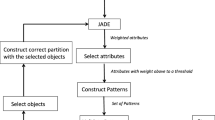Abstract—
The paper presents a method for automatically detecting in data practically useful and interpreted regularities for decision making. The method uses the compactness hypothesis and analyzes estimates for the mutual placement of class patterns in decision spaces. Class patterns are represented as cluster structures constructed from training sample data. The results of applying the method to solve a classification problem based on a real data set are demonstrated.

Similar content being viewed by others
REFERENCES
N. Marz and J. Warren, Big Data: Principles and Best Practices of Scalable Realtime Data Systems (Manning, Shelter Island, NY, 2015; Williams, Moscow, 2018).
A. G. D’yakonov, Data Analysis, Learning from Examples, Logical Games, WEKA, RapidMiner and MatLab Systems (Izd. Otd. Fak. Vychisl. Mat. Kibern. Mosk. Gos. Univ., Moscow, 2010) [in Russian].
V. Mayer-Schönberger and K. Cukier. Big Data: A Revolution that Will Transform How We Live, Work, and Think (Eamon Dolan/Houghton Mifflin Harcourt, Boston, 2013; Mann, Ivanov i Ferber, Moscow, 2014).
J. S. Hurwitz, A. Nugent, F. Halper, and M. Kaufman, Big Data For Dummies (Wiley, Hoboken, NJ, 2013); Simply about Big Data (Eksmo, Moscow, 2015) [Russian translation].
D. Cielen, A. Meysman, and M. Ali, Introducing Data Science: Big Data, Machine Learning, and More, Using Python Tools (Manning, Shelter Island, NY, 2015; Piter, St. Petersburg, 2017).
S. Raschka, Python Machine Learning (Packt Publishing, Birmingham, 2015; DMK Press, Moscow, 2017).
P. Flach, Machine Learning: The Art and Science of Algorithms That Make Sense of Data (Cambridge University Press, Cambridge, 2012; DMK Press, Moscow, 2015).
A. A. Barsegyan, M. S. Kupriyanov, V. V. Stepanenko, and I. I. Kholod, Data Analysis Technologies: Data Mining. Text Mining, Visual Mining, OLAP (BKhV-Peterburg, St. Petersburg, 2007) [in Russian].
N. G. Zagoruiko, Applied Methods of Data and Knowledge Analysis (Inst. Mat. Sib. Otd. Ross. Akad. Nauk, Novosibirsk, 1999) [in Russian].
J. T. Tou and R. C. Gonzales, Pattern Recognition Principles (Addison-Wesley, Reading, MA, 1974; Mir, Moscow, 1978).
A. D. Zakrevskiy, Recognition Logic (Nauka i Tekhnika, Minsk, 1988) [in Russian].
V. N. Vapnik and A.Ya. Chervonenkis, Theory of Pattern Recognition. Statistical Problems of Learning (Nauka, Moscow, 1974) [in Russian].
Yu. I. Zhuravlev, M. M. Kamilov, and Sh. E. Tulyaganov, Algorithms for the Computation of Estimates and Their Application (Fan, Tashkent, 1974) [in Russian].
A. G. Arkad’ev and E. M. Braverman, Training a Machine to Recognize Patterns (Nauka, Moscow, 1964) [in Russian].
M. M. Bongard, Recognition Problem (Nauka, Moscow, 1964) [in Russian].
V. I. Vasil’ev, The Problem of Pattern Recognition Learning (Vyshcha Shkola, Kiev, 1989) [in Russian].
V. V. Krasnoproshin and V. G. Rodchenko, “Learning by precedents based on the analysis of the features properties,” Dokl. BGUIR, No. 6 (108), 35–41 (2017).
R. Callan, The Essence of Neural Networks (Prentice Hall Europe, London,1999; Williams, Moscow, 2001).
A. V. Nazarov and A. I. Loskutov, Neural Network Algorithms for Forecasting and Optimization of Systems (Nauka i Tekhnika, St. Petersburg, 2003) [in Russian].
S. Haykin, Neural Networks: A Comprehensive Foundation, 2nd ed. (Prentice Hall, Upper Saddle Rived, NJ, 1999; Williams, Moscow, 2006).
L. A. Belozerskii, “Modern view of the compactness hypothesis,” Iskusstvennyi Intellekt, No. 3, 6–12 (2005).
V. V. Krasnoproshin and V. G. Rodchenko, “Cluster structures and their application in data mining,” Informatika, No. 2 (50), 71–77 (2016).
V. Rodchenko, “Pattern recognition: supervised learning on the bases of cluster structures,” in Pattern Recognition and Information Processing, 13th International Conference PRIP 2016, Minsk, Belarus, Ed. by V. Krasnoproshin and S. Ablameyko, Communications in Computer and Information Science (Springer, Cham, 2017), Vol. 673, pp. 106–113.
UCI Machine Learning Repository, D. Dua and E. K. Taniskidou (admins) (University of California, School of Information and Computer Science, Irvine, CA, 2017). http://archive.ics.uci.edu/ml
Author information
Authors and Affiliations
Corresponding author
Ethics declarations
The author declares he has no conflict of interest.
Additional information

V. G. Rodchenko. Born 1960. Graduated Leningrad State University 1982. Received a PhD in engineering in 1999. Currently works as assistant professor at Department of Modern Programming Technologies at Grodno State University. Research interests: artificial intelligence, pattern recognition, data mining. Author of more than 70 articles.
Rights and permissions
About this article
Cite this article
Rodchenko, V. Automatic Detection of Hidden Regularities Based on the Study of Class Properties. Pattern Recognit. Image Anal. 30, 224–229 (2020). https://doi.org/10.1134/S1054661820020145
Received:
Revised:
Accepted:
Published:
Issue Date:
DOI: https://doi.org/10.1134/S1054661820020145




